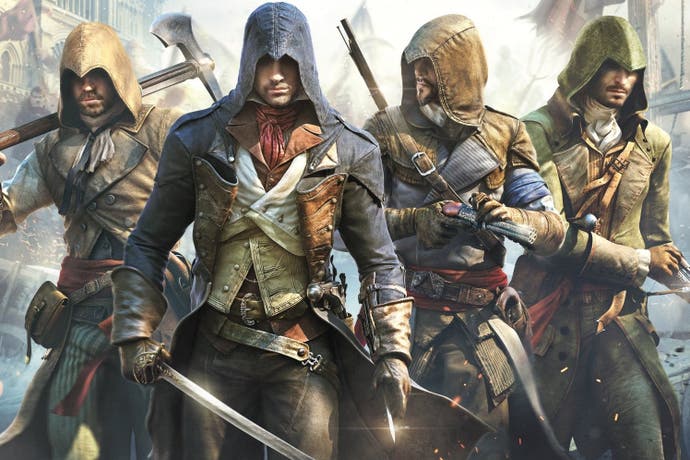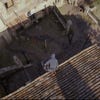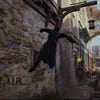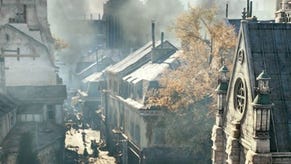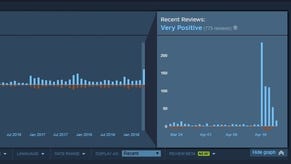Does Assassin's Creed Unity feel like a generational leap?
Or are we still stuck in the past?
In development over the last three years for PlayStation 4, Xbox One and PC, Assassin's Creed Unity discards support for last-gen consoles to establish new technical ground. Set against the backdrop of late 18th-century Paris in violent revolt, riots are brought to life by a new animation system, improved facial animation technology and a huge ramp up to 5000 concurrent NPCs to fill out the crowds. But with Assassin's Creed 4 already delivering a rock-solid 30fps experience, is there actually any headroom for these lavish extras to explore? And do they reflect the stated ambition?
We only get a one-on-one presentation of the game at E3, rather than a direct hands-on to explore the world ourselves, but despite all control being handled by a developer - who plays through the Reign of Terror mission seen in Ubisoft's E3 conference - it's still possible to draw some early conclusions. In terms of setting, for example, our first reaction to Unity is that it's something of a sidestep from Black Flag, moving away from the last game's lush South Pacific jungles to return to its roots - recreating landmarks such as the Bastille and Notre Dame in another bustling city setting.
This sense of familiarity is accentuated by the rigid geometry of the world, which you could argue doesn't feel that far removed from the capabilities of PS3, Xbox 360 or Wii U. This is still a world of crates, flagpoles and other objects that have been deliberately placed to aid Arno's fluid parkour navigation, and this recognisable visual language puts you in mind of older games no matter how beautiful the textures.
Once you go past that, however, Unity starts to impress. Running on a PC with similar specifications to Xbox One (or so we're told), and reputedly targeting full 1080p according to the Ubisoft staff on hand at the show (although we've been around the block enough times to take that with a pinch of salt), it's a wonderfully detailed game. The in-game architecture has clearly been laboured over meticulously, while the draw distances hark back to Ezio's trilogy's most gorgeous vistas. The cityscape isn't too far removed from what we've seen in the past, then, but there are key embellishments.
One of these is a simple thing: the rickety, uneven tiling on the Parisian rooftops, which causes new assassin Arno Dorian to race around at a slant, with cloth physics to match. It's all achieved with a new cloth physics engine, which allows his cloak to billow dynamically behind him according to the momentum of his parkour flips and rolls, and it creates a subtly but powerfully different effect. At street level, the normal mapping used across the decaying, stripped walls of the slums is also impressively detailed, with no hint of poor filtering as your eyes meet the horizon.
Assassin's Creed Unity is being touted as a return to true stealth, something that series hasn't spent that much time dabbling in since its original instalment, so there's a new dedicated crouch button and jumping is more tightly bound to camera direction. A whole range of new animations stem from this system, with each leap to a lower ledge producing a new move based on the distance and angle. It's a move-set unlike anything we've had access to on last-gen platforms, and the only slight technical disappointment is that there's no per-object motion blur to heighten it, which might have added a true next-gen flourish, although there is the full-screen form of the effect.
Adding to the sense of seamlessness is the ability to access building interior areas with no loading screens - a liberating change to the engine design that makes the world at last feel like an integrated whole. This has a knock-on effect for the approach to assassination missions, with an Eagle Pulse ability available to players that allows you to survey nearby houses containing enemies. With all the intel you need, you can then access the target room from top-level windows or the lower storeys to finish the kill.
Interiors are key, then, but the game's main focus is still outdoors, where the revolution is under way, and in particular the unruly streets. We've seen hundreds of NPCs together in Assassin's Creed before (notably in Assassin's Creed 3's early auditorium section), but it is rare, and the developers clearly want to go for broke here by firing up thousands of individuals and crowding them onto the screen. Not only that, but their AI is improved, with skirmishes, pick-pocketing and other events unfolding as you pass.
There are some rough edges in this early build. In their masses, we see some unusual, erratic twitching among individual NPCs at a distance, suggesting issues with the way characters interact in groups. Enemies not involved in combat also snap uncannily into an idle position once the player locks onto someone (something that was even noticeable during Ubisoft's conference), and there is some obvious shadow pop-in across the world, particularly when looking down from high vantage points. But clearly tackling many, if not all of these things will be on the developers' to-do list before release rolls around.
Given all these changes, though, how does performance hold up from the solid 30fps lock of Assassin's Creed 4? At this stage it's hard to say, particularly given that we're only seeing the game on a PC with unknown specs, even if we're told they're comparable to Xbox One. (PC won't quite replicate the ESRAM set-up unique to the console, it's worth noting, while the inexpensive Radeon R7 260X graphics card easily outpace Xbox One based on every title we've played, and it's hard to imagine the demo PC is using such limited hardware.) But there is currently no frame lock in evidence; v-sync is enabled, but we get a frame-rate that ranges from 20fps among busy crowds to around 50fps in the less demanding interiors. Optimisation will continue up to and perhaps even beyond release, of course, but this is still a little wobbly for our liking.
In many ways, then, Assassin's Creed Unity does feel like the generational leap we've been waiting for, at least in visual terms. The setting helps. Compared to the jungle outcrops and naval war-faring of last year's Black Flag, Unity's environments are a little stricter and more predictable in some aspects of their technical scope. But this allows the developer to have its cake and eat it too, delivering much richer, denser environments even though a keen observer might note that they are a little less ambitious than the world of Black Flag in other respects. Make no mistake, though: that richness and denseness is tangible and welcome. The detail, the lighting and the sheer texture of the environments really catches and holds the player's attention. A few technical questions remain, of course, as they often do around things like frame-rate at this stage, but this is a solid start.
The bigger question, though, will be whether Assassin's Creed Unity is a generational leap in gameplay terms. The sliver of gameplay we see at E3 is inconclusive on that front, adding some welcome touches - not least four-player co-op - but perhaps playing it a little safe in other regards. Come the game's launch on 28th October, we look forward to seeing whether Ubisoft Montreal can deliver on the technical promise and give us a game that lives up to it as well.
